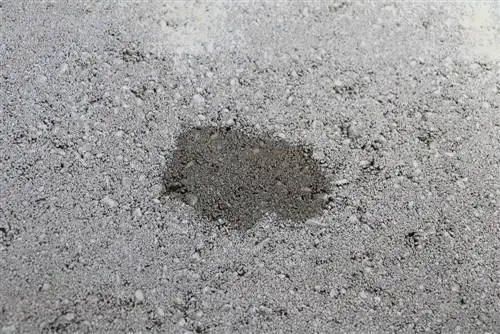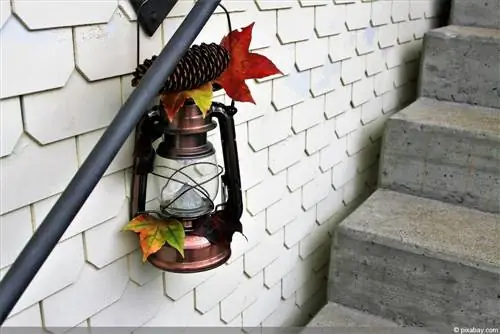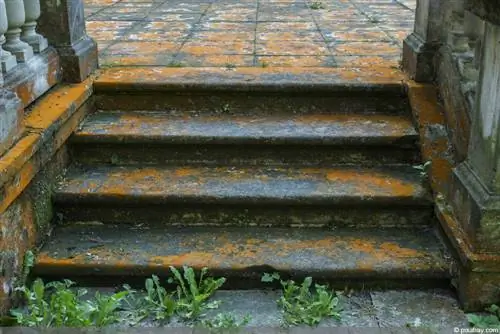- Author admin [email protected].
- Public 2023-12-17 03:39.
- Last modified 2025-01-24 12:45.
Whether it's a concrete wall, wall or staircase, cleaning is a must and is not easy, especially when there are stains on the concrete. Below you will learn how to choose the right stone cleaner and how to properly clean the concrete using home remedies:
Concrete: No material for every cleaner
Concrete is made according to a simple basic recipe from ingredients that nature provides: Cement is the core and the “miracle cure” that ultimately ensures that a rock-hard material is created. This mineral building material is named after the Latin “caementum”=“quarry stone, building stone” because it must be finely ground to be used. While under the Romans unfortunate people were “allowed” to laboriously grind, today cement is made in the cement works from the raw materials limestone and clay (which are called “marl” when they are present as a natural mixture, as is often the case). These basic materials are usually not the only ingredients; quartz sand and rock containing iron oxide are often added because the mixture is easier to burn (“sinter”). These raw materials are now ground and then heated to around 1,450 °C so that some of them fuse together. The result of this sintering is the so-called cement clinker. Which in turn is ground into cement after cooling with fly ash, gypsum, blast furnace slag and limestone. The mixture and dosage of the components and the degree of fineness of the grinding determine the type of cement.
It is only in this form that cement develops a special property: When it is mixed with water, there is a chemical reaction, the cement hardens and then remains solid. However, this cement is not yet concrete, but rather just the binding agent that ensures that the concrete becomes hard. Concrete is only created when aggregate in the form of sand or gravel, various additives and then water are added to the cement. And there is not just one concrete recipe, but many; Depending on the mixture, the properties of the concrete are adapted to the respective requirements. Many of the properties of concrete can be influenced, and more are constantly being developed because new compositions and additives are constantly being tested and used.
This production has been briefly explained in more detail because it gives you important information on how to clean the material: It is not just a block of stone that you can attack with everything in the cleaning cupboard. Concrete consists of many individual substances with air inclusions, which react with each other when mixed and form a solid bond. A more or less solid bond that is prone to errors in several respects during production: the concrete composition must be calculated precisely and correctly, when mixing concrete the correct air content must be introduced into the water-cement ratio, rules must be followed when transporting fresh concrete, so that the quality of the concrete does not suffer; And when pouring itself, there are numerous rules that must be observed, which also affect the susceptibility of the concrete to stains.
The complexity of the manufacturing process results in the first two rules for cleaning concrete, the most important rules:
- Whatever falls, flows, drips onto the concrete should be removed immediately, especially indoors. Depending on the substance emerging and the existing seal, simply wiping it away is sufficient or it is recommended to vacuum it up with absorbent material before cleaning
- If there are substances that could cause discoloration or react with the concrete, rinse immediately with water, if necessary several times.
Stone cleaner for walls, walls and stairs made of concrete
Since concrete is very popular again, especially for indoor use, there are a lot of stone cleaners available for concrete. Concrete can also be cleaned well with stone cleaner, but only if you buy the right stone cleaner. Acid is not for concrete, even if the cleaner says 10 times that it can be used for concrete (acid is used to etch concrete surfaces to the point where they become receptive to all sorts of special treatments).
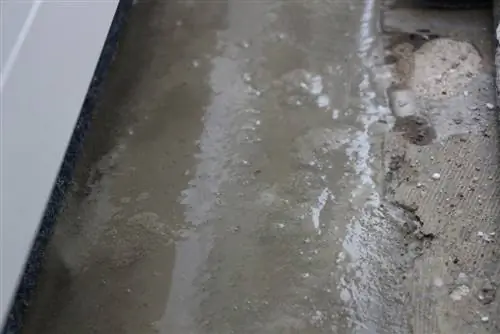
Stone cleaners (without acid) can contain many substances from the large chemical kit, which you should find out about individually if you want to run a household without critical substances. Ask for the safety data sheet, which lists all substances that must be listed due to hazard labeling regulations. The technical data sheet is not enough because it does not provide you with the information you need to really find out about each individual ingredient.
The seller could tell you that as a private customer you have no right to request the safety data sheet (in “consumer-friendly Germany”, only commercial customers actually have that), but that is no longer of any real use to him in the age of the Internet. You could then tell the seller that you have the right not to buy from him, look for the relevant safety data sheet on the Internet and then either buy the product somewhere else or just not buy it.
Once you have found a stone cleaner that meets your requirements in terms of ingredients, it's time to try it out. And if possible, for everyday, light dirt, so you can quickly get a feel for what the corresponding cleaner can do when you really need to remove tough dirt.
Tip:
There is “the concrete cleaner for all cases” (if you want to add something to the water, which “woops” most of every damp or wet cleaning): A light soda solution that has no acid in it and cleans very gently. For cleaning purposes, special washing soda is sold, sodium bicarbonate, which, when dissolved in water, is slightly more aggressive and therefore quicker to clean (1 tbsp per liter). The many people who constantly have cooking soda in the house can also mix this gentler soda into a soda solution for cleaning concrete, which will clean away all non-extremely staining stains without damaging the concrete.
Stain prevention on concrete
The fresh concrete must be protected as soon as it has been compacted in the formwork. In the first few days after installation, environmental influences (very rapid heating or cooling, becoming damp or drying out, etc.) can make the concrete susceptible to stains if it is not allowed to harden in peace under special foil or insulation.
Whether you can protect your concrete wall, concrete wall or concrete stairs in some way after it has hardened depends on the concrete mix used and should be told to you by the manufacturer. If this protection is intended to make the surface leak-proof, you need to be a little suspicious, because experience shows that it doesn't always work well and for a long time. In this case, it would be best if the manufacturer could provide you with proof of an object that has been used for a long time and that has exactly this protective mandate.
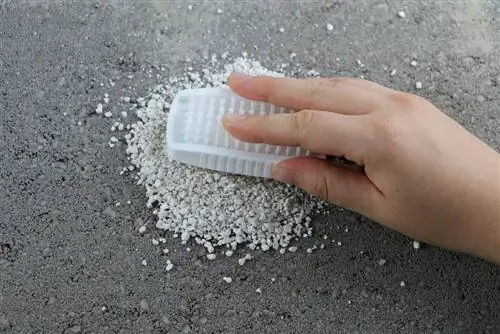
Otherwise, the best stain prevention for concrete elements is to remove any stain as quickly as possible. If the stain is completely fresh, it is best to first use absorbent material: kitchen or toilet paper for liquids, sand and cat litter for fatty liquids and liquid fat, the vacuum cleaner removes staining, granular masses. The stain is then treated with hot water until nothing can be seen - apply water and blot away, repeat if necessary.
Gentle cleaning for walls, walls and stairs made of concrete
You can often get by without special stone cleaners, here are the alternative methods for cleaning various concrete surfaces:
Exposed concrete
Exposed concrete is pure concrete, even on the exposed concrete surfaces, which are therefore among the most sensitive concrete elements. But exposed concrete looks great and is therefore often used in interior design; In addition to walls, walls and stairs, also for worktops, washbasins and table tops, which become visibly dirty even more quickly and more clearly.
With exposed concrete, every cleaning attempt begins with clear water; according to the manufacturers of concrete furniture, simple curd soap should serve well as support. Stubborn stains should be gradually “softened or cleaned away” with a curd soap solution.
Exposed concrete can be oiled or waxed, even with home remedies; but please look for instructions for the first order, there are a few things to consider.
Precast concrete block
Precast concrete block may develop efflorescence if it was recently poured. Their origin and removal are discussed in detail in the article “Removing stains from paving stones and concrete paving”.
Screed flooring
Screed flooring often causes problems immediately after moving in because construction residues such as synthetic resin residues, tile adhesive and paint have to be removed.
A special concrete cleaner from a specialist retailer should first be used here. Please do not experiment, the cleaning agent should be designed for this concrete and this level of contamination. If the tile adhesive is hard, there will be a shortage of usable cleaners; using a hammer and chisel will get you there. Once the bulk of the adhesive has been removed, the quickest way to get the area looking attractive again is to sand the concrete down a little.
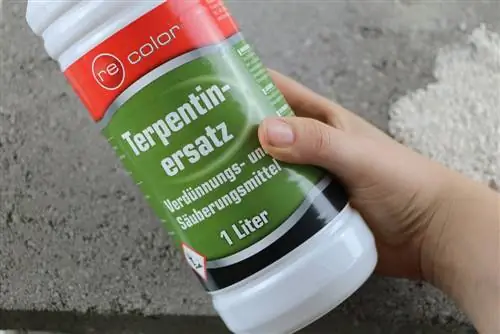
Grease stains are not easy to remove from concrete floors, even when they are fresh:
- Fresh stains of light fat/oil can be washed away with boiling water in appropriate places, but then you will need plenty of boiling water and repeat the process several times.
- The alternative is vacuuming, with sand, cat litter, commercially available oil binding agents (which may have to remain on the stain for weeks) or special cloths for absorbing oil (e.g. LanTex Plus), and then, if necessary, damp cleaning first the soda solution described above, then with boiling water.
- Motor oil dripping from the car onto the screed floor in the garage should be vacuumed up/binded as freshly as possible, then the area must be cleaned with degreaser in water.
- The soda solution can be used again as a degreaser; alternatively, a dishwasher tablet dissolved in water will also work.
- Old oil stains should first be dissolved before the oil is bound and cleaned away.
- Depending on the density/color of the oil, this works better with turpentine, engine cold cleaner, commercially available Oil-Ex (available from Lithofin, for example), and the dishwasher tabs (this time dissolved in boiling water) should also help.
- Absorb the dissolved grease with a sponge cloth that is as absorbent as possible, then scrub the remaining stain vigorously with degreaser in water, then rinse with hot water, several times if necessary.
- Very old dried oil stains should be soaked slowly, e.g. B. with a slurry of chalk, fine sand or pumice powder (pumice stone powder) and white spirit, which is applied to the stains and covered with foil. Soak layer by layer, brush away, soak again until the stain is gone.
- The “magic cotton wool” invented by Deurex AG in Zeitz is completely new. It has just received the European Inventor Award and absorbs oil but repels water.
Tip:
Garage floors often get oil stains from cars, but sealants are offered that are intended to effectively protect the concrete floor; often in the form of “concrete color”, which also makes the floor attractive. However, whether the seals do what they promise should be checked carefully. Sometimes the pollution gets worse; It is not uncommon for the concrete paint to react chemically with the plasticizers in the car tires.

